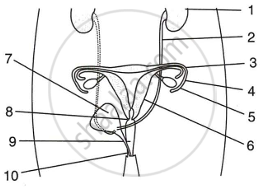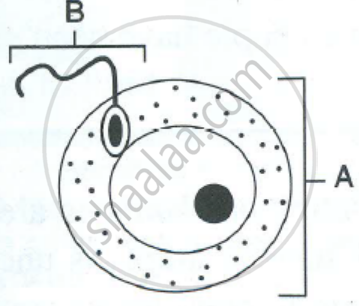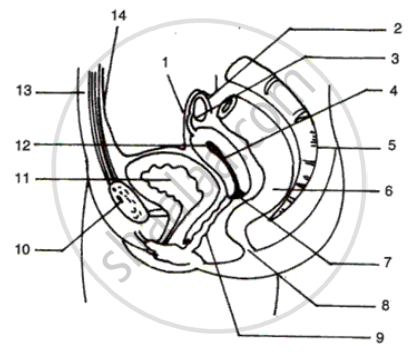Advertisements
Advertisements
प्रश्न
Name any three parts of the female reproductive system in human beings. Write one function of each.
उत्तर
Parts of the female reproductive system in human beings:
(1) Ovary: The ovary produces the female gamete or egg and the female hormone oestrogen.
(2) Uterus: The uterus accommodates the growing foetus till it completes growth.
(3) Fallopian tube or oviduct: The fallopian tubes carry the egg from the ovary to the uterus.
APPEARS IN
संबंधित प्रश्न
Name the parts of the human female reproductive system where
i. fertilisation takes place
ii. implantation of the fertilised egg occurs
Which of the following is not a part of the female reproductive system in human beings?
What are the different methods of contraception?
What could be the reasons for adopting contraceptive methods?
State the changes that take place in the uterus when Implantation of embryo has occurred
The pituitary hormone which stimulates contraction of uterus during child birth.
The diagram shown below is the longitudinal section of a testis of man. Study it carefully and answer the questions that follow

(i) Label the parts numbered 1 to 3 in the diagram.
(ii) In which part of the testis are the sperms produced?
(iii) State the functions of the parts labelled 1 and 3 in the diagram.
State the main function of the Leydig cells
Which part of the human body passes sperms from a man to a woman?
For how much time does menstruation last in human females (or women)?
Write the names of male sex hormone?
What is gestation period? How much is the gestation period in humans?
Name the organs which produce ova (or egg cells) in human females.
Describe the process of fertilisation in humans and development of embryo briefly.
In human males, the testes lie in the scrotum outside the body because it helps in the
(a) process of mating
(b) formation of sperms
(c) easy transfer of sperms
(d) all the above
The ratio of the number of chromosomes in a human zygote and a human sperm is ______
Given below is a diagram of two systems together in the human body.
 |
- Name the systems.
- Name the parts numbered 1-10.
- Describe the functions of the parts 3, 4, 5 & 6.
- What will happen if the part 3 on both sides gets blocked?
The diagram below represents two reproductive cells A and B. Study the same and then answer the questions that follow:
 |
- Identify the reproductive cells A and B.
- Name the specific part of the reproductive system where the above cells are produced.
- Where in the female reproductive system do these cells unite?
- Name the main hormones secreted by the (1) ovary (2) testes.
- Name an accessory gland found in the male reproductive system and state the function of its secretion.
Write two examples of sexually transmitted diseases caused by virus.
Trace the path of sperms from where they are produced in human body to the exterior.
Write the functions of secretions of prostate gland and seminal vesicles in humans.
Describe in brief the role of vas deferens in human male reproductive system.
Explain how the sex of the child is determined at the time of conception in human beings.
Fill in the blank.
In humans, sperm production occurs in the organ ----------------.
Diagram shows the reproductive system of female human beings:
(i) Name the parts numbered 1 to 14.
(ii) Normally, after how many days does an ovary release an egg?
(iii) Where are the sperms released during coitus?
(iv) What is the role of sperms after their ejaculation in vagina?
(v) What is the function of the organ numbered 5?
(vi) What is the gestation period in human?

Choose the correct answer:
Binary fission is a method of __________
Choose the correct answer:
First menstrual cycle is known as ___________
Give the function of the following:
Uterus
Define the following:
Parthenogenesis
Define the following:
Gestation
Answer the following question.
What is contraception? List three advantages of adopting contraceptive measures.
Give Reasons
At the time of birth, the testes descend into the scrotal sacs.
The below diagram is of a developing embryo is a mother’s womb:

(i) Write the functions of the placenta, amnion, and umbilical cord.
(ii) How are the waste products of a fetus removed?
(iii) What is the gestation period?
Choose the Odd One Out:
What is inhibin? State its functions.
Which one of the following statements about human sperm is correct?
Human eggs are______.
Gestation period in man
